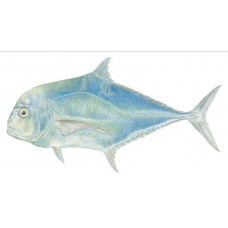Latin name
Alectis ciliaris
Other names
Cuban jack, Atlantic threadfin, pennantfish, threadfin mirrorfish, trevally; Afrikaans: draadvin-spie lvis; Arabic: bambo, tailar; French: aile ronde, carangue, cordonnier; Hawaiian: papio, ulua; Malay/Indonesian: cermin, ebek, rambai landeh; Portuguese: xaréu africano; Spanish: caballa, chicuaca, elechudo, jurel de pluma, paja blanco, palometa, pampano, sol, zapatero.
Identification
The most striking characteristic is the four to six elongated, threadlike filaments that extend from the front of the second dorsal and anal fins. These filaments usually disappear or fade away as the fish grows. The shape of the body changes as it grows. Starting short and deep, it becomes more elongated when the fish reaches 14 inches in length, and the forehead becomes steeper and blunter. In both young and adult fish, the body is strongly compressed, and the posterior halves of the body are triangular shape. The lateral line curves smoothly but steeply over the pectoral fins and has 24 to 38 relatively faint scales in the straight part and 120 to 140 scales. Shiny and silvery, large fish may be light bluish-green on the back. All fish may have dark spots on the top of the caudal stems and on the front of the second dorsal and anal fins. Juveniles have five to six pelvic stripes.
Distribution
They are found in the western Atlantic Ocean from Massachusetts and Bermuda to Brazil, as well as throughout the Caribbean Sea and the Gulf of Mexico. In the eastern Pacific, they are found from Mexico to Peru.
Habitat
Inhabiting waters as deep as 300 feet, they often prefer to stay near the bottom above rocky reefs and around wrecks. They may form small, somewhat polarized schools, although as adults they are usually solitary.
Size
This species reaches a length of 42 inches and can grow to 60 pounds. The world record in all tackle is considered a Florida fish weighing fifty pounds, eight ounces. Twenty- and thirty-pound individuals are often found in South Florida.
Life history and Behavior
No information
Food and feeding habits
It feeds on sessile or slow-moving crustaceans, small crabs and sometimes small fish.
Reproduction
No information
| Classification | |
| Phylum | Chordata |
| Class | Actinopterygii |
| Squad | Carangiformes |
| Family | Carangidae |
| Genus | Alectis |
| Species | A. ciliaris |
| Features | |
| Conservation status | Least Concern |
| Habitat | Pelagic |
| Life span, years | No information |
| Maximum body weight, kg | 22.9 |
| Maximum length, cm | 150 |
| Sailing speed, m/s | No information |
| Threat to people | Edible |
| Way of eating | Predator |



